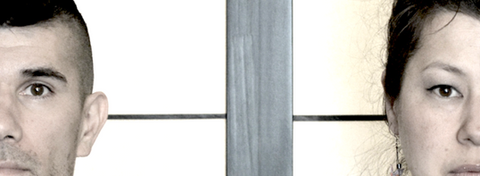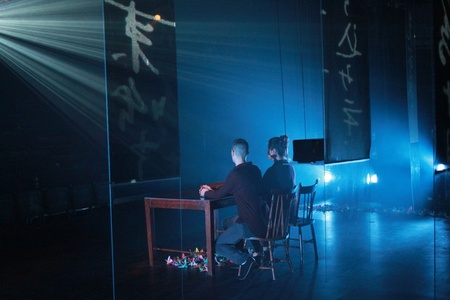When Julie Tamiko Manning and Matt Miwa first in 2009 as members of the English Theatre acting company at Ottawa’s National Arts Centre, they discovered a commonality in their backgrounds as they began to compare notes. Both are mixed-race Japanese Canadians, and both their families were interned in Tashme, the western-most Internment camp, during World War Two. Out of those early conversations came The Tashme Project: The Living Archives. The self-described verbatim/documentary-theatre play traces the history and common experience of the Nisei (second generation Japanese Canadians) through childhood, WWII internment and post-war resettlement east of the Rockies.
Pieced together from over 70 hours of interviews with 20 Nisei from Vancouver, Toronto, Hamilton, Kingston, Ottawa and Montreal. The two-person show features Manning and Miwa who portray the voices of the over 20 elders, sharing their memories of childhood, internment and post-WW2 resettlement east of the Rockies.
The Tashme Project is an embodiment of Nisei character, language, spirit, and story. The actors portray the voices of both men and women interviewees as they seek a deep emotional and spiritual connection with the stories of their elders. The Tashme Project’s first full production was presented in May 2015 at The MAI (Montréal, arts interculturels) and produced by Tashme Productions in association with Playwrights’ Workshop Montreal. It continues to be presented across Canada, including the Great Canadian Theatre Company in Ottawa.
The Bulletin talked to Julie and Matt via email.
* * * * *
I last talked to you guys in 2015. At that time, The Tashme Project had already been in production for five years, with staged readings across the country. You were just preparing to launch the world premiere in Montreal. It’s four years on and you’re preparing to produce the show in Vancouver – it clearly has legs! Are you surprised and the durability of the show?
Yes and no. Yes, because new Canadian theatre (specifically anglophone) is not known for lasting longer than its initial run. No, because we have worked really hard to get the attention that we’re receiving. It’s also surprising to realize that our audiences are interested, hungry, and open to diverse Canadian experiences, especially to stories of where Canada has gone wrong in the past. I hope that this reflects a desire to acknowledge and own their part in a country that is not the perfect Canada they grew up believing in.
For those of us who have not seen either the staged reading or the finished show, tell us how the show is structured.
Tashme is a memory play and its content is the verbatim oral histories of the 20 Nisei interviewees that we met across Canada between 2011 and 2013. Onstage, we as performers shift from one story to the next, and from one Nisei to the next, as we embody each particular interviewee with their particular voice, quirks, perspective and sense of humour. The stories are arranged in chronological order, and so the play passes from memories of childhood in B.C. before the war, right through the interment and post-war resettlement up to present day. Through this collection of individual experiences, we hope a broad picture of the Nisei experience in Canada emerges, but we are also committed to showcasing how different each experience was and how delicate memory in general can be.
Can you talk about some of the reactions you’re received from audience members...
Some of the most emotional and meaningful reactions are from members of the Japanese Canadian community, especially when the audience is intergenerational. Nisei and Sansei who went through internment will bring their children and grandchildren to the show (or Sansei and Yonsei will bring their parents and grandparents to the show) and when they stay afterwards to talk to us, we get to see a little bit of a silence being broken between family members—often the show will open up a space where the older generation can reminisce and communicate their childhood experiences and the younger generation is wanting to learn about their family history in Canada. This reaction is ultimately the one we were hoping for when we created this piece: to build those bridges being generations, as well as with non-Japanese Canadians.
I imagine some of those you interviewed have seen the show. What has their response been?
Most of the interviewees have seen the show in some form at one time or another. We are thrilled to be bringing the show to Vancouver where the last two of our interviewees who have not yet seen the show, live. While it can be quite nerve wracking to know that interviewees are in the audience, and that we are not only sharing their personal histories but interpreting their voices and personalities, we have only been met with gratitude and good reactions. The best is seeing in the audience the faces of the interviewees as they nod along to their own stories, and it has meant everything to us to have received their blessing. These stories have become so important for us – we get to recite them regularly! but in doing so, we sink deeper into them, and they comfort and transform us. It is wonderful to be able to share this with the people who gifted them to us.
In the process of putting together this show, you talked to 20 Nisei elders. Was there one story that stuck with you, or moved you in some way?
There have been so many wonderful stories that it’s hard to choose one, and so many of the stories are very similar, even between interviewees who didn’t grow up in the same place. It is the most moving to discover that we are more of a community than we think. Even after being torn apart multiple times, we are all so interconnected because the imprint of internment experience goes so deeply. We have been so lucky to meet so many JCs from across Canada, from our interviewees to the audience members, we feel like our family extends every time we do the show. What sticks with us is not necessarily any story but the resilience of every one of our elders.
As third and fourth generation Hapa, it must feed your soul to be able to delve so deeply into these stories. Can you talk about what this show has given you, in terms of your identities as JCs.
As Hapa, who often go about their lives with Japanese being a “secret” identity, Tashme has become an anchor for our Japanese identity. We’re sure that many Hapa today in Canada will tell you that other then being with their family, they do not know how to “be” Japanese. We don’t look Japanese, speak Japanese and we no longer live in Japanese-y households and we long for a tangible connection to our cultural heritage.
This is why we are so grateful for Tashme and to our interviewees. We actively get to work not only with Nisei testimony, but with their particular way of speaking English; their grammar and their accent. What’s more, the more we perform this show and repeat these stories, the deeper we can understand and appreciate them. There is so much wisdom inherent in the stories we have been gifted, both in terms of what is said and especially in what is not said, but what lies very present and powerful below the surface of the words. It is such a comfort to know that we will have these stories with us for the rest of our lives.
You workshopped the show intensively before launching the full version, but I imagine the show has continued to evolve. Is it pretty much fixed, or does if shift over time?
The show did evolve over time. The readings were wonderful opportunities to dramaturg the script on our feet, especially when there were Nisei in the audience. They would react a certain way and we would go back to look at a section to do edits or additions. We have also received a lot of support from both funders and organizations like The Cole Foundation, Canada Council for the Arts and Playwrights’ Workshop Montréal, to continue to finesse the dramaturgy and performance, which referring back to the first answer, is not a common thing in Canadian theatre. It is being published this summer and we are in the middle of touring it so right now it is pretty fixed, but that doesn’t mean that we won’t change it again in the future. It’s actually really hard to stop because every time we perform the show, we hear more feelings, stories and critical response from the audience and it is such an important piece for us that we just want to make it better and better.
You’ve been working together for a long time now. How’s that going?
We work well together and in fact, we have learned to harness the particular strengths we each bring to all aspects of this project, from producing to performance. With just the two of us, there are so many more jobs to do then just getting on stage (although we wish there wasn’t!). This has been the longest and deepest collaboration either of us has ever embarked upon and it is built on mutual respect, and a great need to honour our interviewees and our Japanese Canadian elders in general.
The project is so rich that we don’t know if it will ever be done; we keep tinkering with it every time it is remounted, and being two very different artists, it is always a long discussion about where and how to bring it to its next step.
Where else is this adventure taking you?
We’re continuing to build more interest in this show – we’d like to go to the States and Japan, but we’re also thinking about a podcast so we can bring to light all of the stories that we weren’t able to put in the show. We’d like to translate the show into French and look to tour the show in Quebec and to other francophone centres. The idea would be to perform the characters of Matt and Julie in French and surtitle the Nisei in French but perform them in English. The Nisei accent is such a beautiful and unique thing, and it will soon disappear as it is quite different from a Japanese accent, so performing the Nisei in English, speaking in the unique way that they speak, is also a way of preserving that identity. We also dream of a comic book/graphic novel to expand our audience and make these stories more accessible to a younger audience.
* * * * *
The Tashme Project: The Living Archives will be performing at the Prismatic Arts Festival, September 18 to 22, 2019, at the Great Canadian Theatre Company in Ottawa.
*This article was originally published by the Bulletin on March 2, 2019.
© 2019 John Endo Greenaway / The Bulletin








